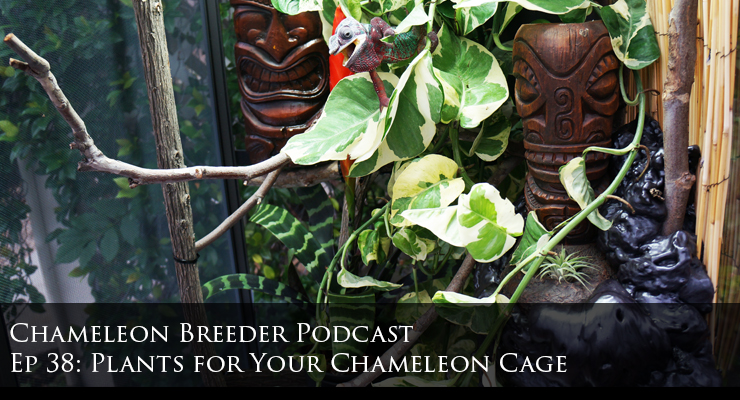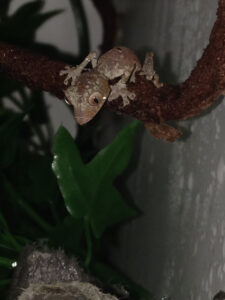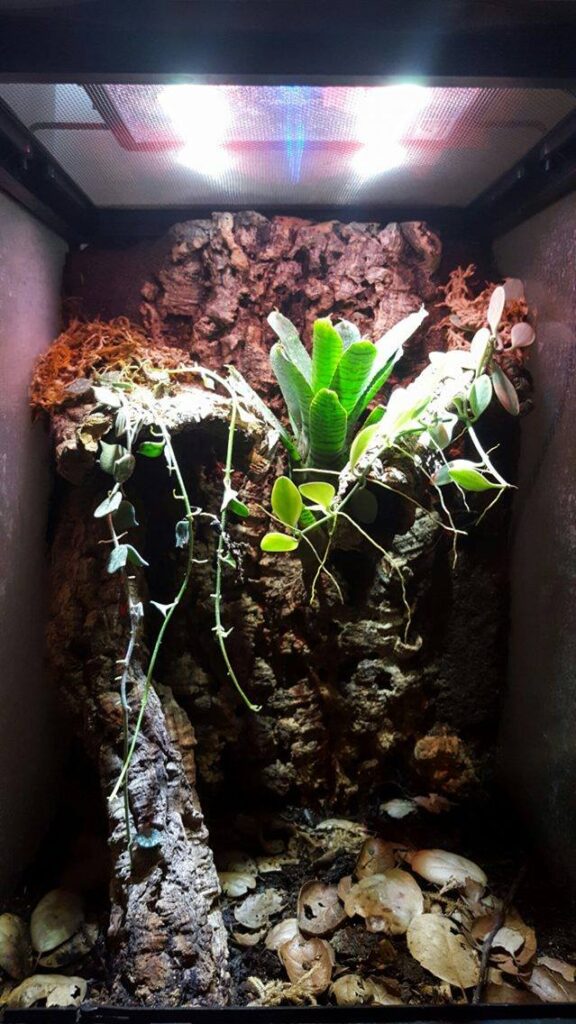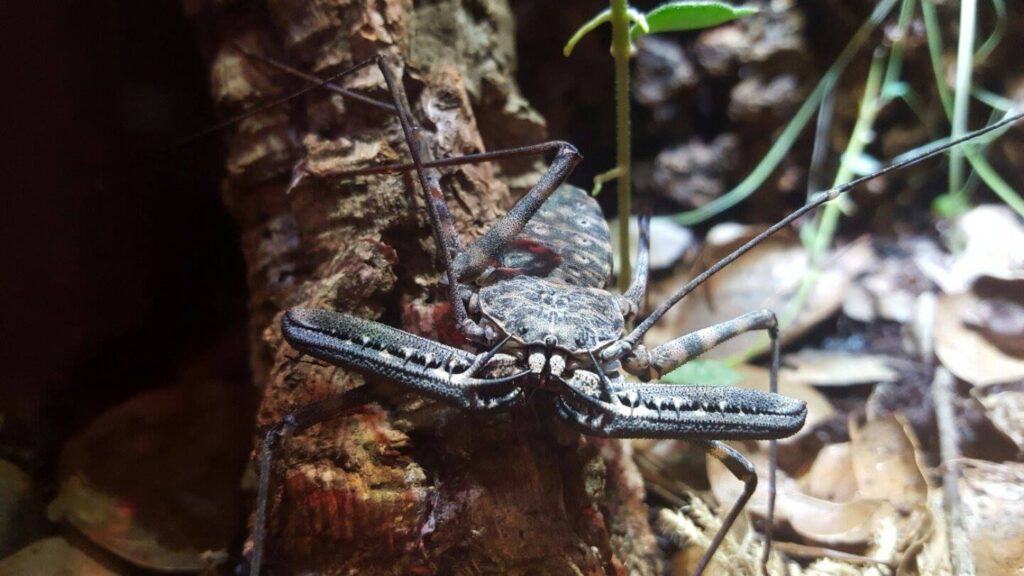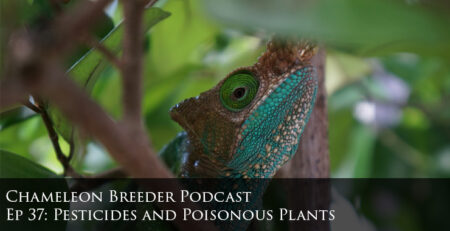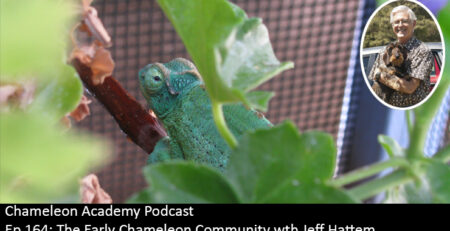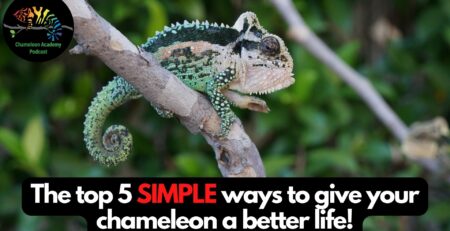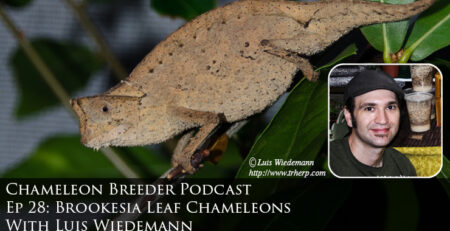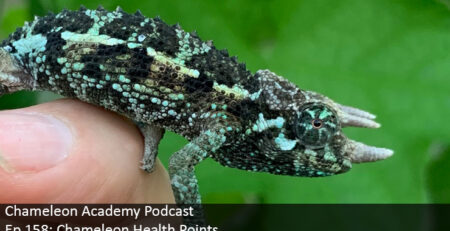Ep 38: Plants for Your Chameleon Cage
Plants are a functional cornerstone of a chameleon’s cage. They are also a source of great beauty. In this episode I get you started on using live plants in your chameleon’s environment. With just a little bit of knowledge you can turn your chameleon cage into an incredible chameleon environment!
Podcast Player
Note: As an Amazon affiliate I may be compensated for items purchased from this page at no additional cost to you.
Items from podcast
Get your SolarMeter 6.5 Here!
Transcript (More or Less)
Good Morning Chameleon wranglers. In have some good news for you! The wait for repaired UVB solarmeters is over. Solarmeters are now starting to be shipped so, if if UVB is a study subject for you, you are now able to get the meters to take your anecdotal observations and put some objective numbers to it. I just got my Solarmeter 6.5 and can’t wait to test my chameleon room cages. The appeal of the 6.5 over the standard 6.2 is that the 6.5 measures only the UVB that promotes Vitamin D3 production whereas the 6.2 measures a greater range. Both are effective so don’t throw out your green meter! But if you are in the market for a new one, I will put my vote on looking into the 6.5. You can find them at many places. I bought mine from Todd Goode at Lightyourreptiles.com. Whenever possible I support people that are active in our community in ways beyond just selling to us. They are usually small businesses so the prices may be higher, but if someone is taking their time to support us with their specialized, hard earned experience you know I’ll be first in line to make sure they are supported however I can so they can keep doing what they are doing. Remember – our community is what we make it to be. Put your money with the business you would like to keep with us. Todd has an open policy of giving you a personalized lighting recommendation based on your specific cage set-up. So that is where my lighting money goes. I understand that some people need to get the cheapest price and will sacrifice quality and service to get it, but if you believe that product quality is important and consider the person selling and supporting the product as part of the package deal then we think alike.
Today is one of my favorite subjects. Plants. Plants are what takes a functional, but sterile cage and turns it into a centerpiece of attention. The cage is no longer just a wrapper for your chameleon, but an entire entity of its own. A beautifully planted cage brings emotional peace, wonder, and takes chameleon keeping from containing an animal to bringing a slice of nature into your home.
Perhaps the greatest opportunity for personal artistry in your chameleon husbandry is your selection and placement of plants in the enclosure. This step can be as simple as placing a centerpiece potted plant in the center of the cage or as complex as including ornamental plants for viewing pleasure.
Where the cage is the canvas and the branches are the skeleton, your plants are the visual life of your chameleon environment. It is the plants that will give your chameleon a variety of places to live and function within the confines of your enclosure. They were designed to literally live on plants so having knowledge of plants is a natural part of chameleon husbandry.
You have probably heard the term “naturalistic vivarium”. This is where the keeper creates an environment. At the most basic level, it is adding plant life. At the other end of the spectrum is a thriving eco-system with air purifying plants and bio-active substrate. Miniature orchids peak out of the greenery occasionally and the entire landscape is constantly in the process of slow growth. If you choose to have animals in this lush environment they take care of themselves with natural behaviors. One of the greatest sources of joy for me are two naturalistic vivariums I have created. One is with Phantasticus geckos and the other is with bumble bee dart frogs. I may have decades of chameleon breeding experience, but know very little about the intricacies of breeding these geckos and frogs. I really couldn’t tell you how to do it. Yet, every year I have multiple gecko and frog babies. I may not know about breeding, but they do and all I had to do is provide enough of a natural landscape for them to be what they are. Pygmy chameleons are the same way. While most chameleons will not do well in groups in the size cages most of us have to work with, a single chameleon in a naturalistic environment will display a number of behaviors you will not see in a sterile cage.
This joy and fascination is, unfortunately, experienced by relatively few chameleon keepers. The roadblock is our mind set. We start with the chameleon and everything flows from there. How big the cage is depends on the minimum size the chameleon will live comfortably in. How much money you spend on equipment depends on how much you spent for the chameleon.
There will be what is probably the largest reptile show on the West Coast this weekend. I will be there with the Dragon Strand chameleon caging booth. And I can guarantee, because I get this at every show, I will have someone come up and ask why they should pay more for the set-up than they do for the animal. And they are not talking about their $1500 parsonii. By “animal” I mean the $35 veiled chameleon across the aisle in the mass baby cage. The cage cost is bad enough, but a misting system? You must be crazy! I am not spending $100 for a misting system for a $35 chameleon!! Oh, have you studied the hydration and hygienic needs of chameleons and have come up with an alternative water system that matches both your lifestyle and your chameleon’s needs? Excellent! Or are you deciding what quality of life this animal will have based on an arbitrary value system developed by humans and adjusted with respect to market forces and geo-politics.
Is it any wonder that old timers develop a bit of an edge and that sporadic eye twitch?
But imagine if you changed things around. Imagine if you started with the experience you would like to create. You find the largest enclosure you can fit in your allotted space. You design a plantscape inside with hidden glens and nondescript plants which, at various times of the year, send out an unexpected bloom. Mosses can be grown in naturalistically made outcroppings. Misting systems can be set up to allow a wide variety of exotic plants. And then you select the proper reptile or amphibian that complements both the size and the type of environment you are able to create in your conditions.
An example of this alternative approach is a hobbyist I had the pleasure of talking with last weekend, Ryan Howe has a passion for vivariums and I was able to see a small vivarium he created for his whip spider. The vivarium was simple at first glance, but the more you looked the more you realized it wasn’t “simple”. It was comfortable. And by that, I mean it looked just like he grabbed a chunk of a hillside and plopped it in his room. There was nothing that looked artificial or deliberate in the rock back and woody outcroppings. It would have been hard to tell if he meant to place the sprig of crawling vine. If I didn’t know it was a specific species of vivarium plant I could easily have imagined it just popping up on its own and going about its way. He spent $250 on this 12” or so cube environment to house a $20 arachnid which you couldn’t see because it had all sorts of places to hide. But there in is the difference in approach. He wasn’t caging a whip spider. He was creating a active slice of nature and the whip spider was just one component of life to complete the experience. And the complete range of behaviors – including when it chooses to emerge and hunt is part of the environment. It is part of the full experience. We can do this with chameleons too, folks!
Though I don’t want to make it seem like this is a new concept. There are a large number of keepers that embrace naturalistic set-ups. Some have been on this podcast. Kevin Stanford, Chris Anderson, Luis Weidenmann to mention a few. And I intend to bring on more guests that work like this. In this podcast I am not inventing these great concepts! I am just bringing the hidden treasures of our community to the spotlight for a moment so that you can see what is possible! These things are already being done and you can do them too!
Sound great? Yeah, but you just figured out that “calyptratus” and “veiled” are the same thing. And are still adjusting to the fact that there is an “a” in Chamaeleo. And I am suggesting you become adept with the blooming cycles of butterworts? Give me a break, Bill! I got enough on my plate figuring out how to gutload crickets. Alas, you are correct. There has to be a starting point and each discovery starts with a first step. And so, today, we are going to start off with the basics of plants. We will review the major plants in the chameleon keeper’s inventory and how to put it all together in a cage. Over the months we will build on this. And together we will push into that third wave of herpetoculture!
Let’s start at the beginning and go over the
Importance of plants in the cage:
The four main functions you want your plants to serve are to provide
1) drinking surface
2) an exposure gradient
3) humidity pockets
4) an aesthetic appeal for the humans.
Drinking surface. Plants for the purpose of providing a drinking surface will have wide leaves. They don’t necessarily have to be big leaves as long as the leaf density is such that water is temporarily trapped on them before eventually evaporating or dripping down.
Exposure Gradient. Next is the exposure gradient and plants are our main tool in providing that. For those new to the four gradients of chameleon husbandry, (Heat, UVB, Humidity, and Exposure) the exposure gradient allows the chameleon to choose how visible to the outside world he or she is. Simply put, your chameleon needs at least one chameleon appropriate hiding places. Ideally, he has a variety to choose from that have varying levels of exposure. We will be getting into some detail as to how to create that soon.
With protection from exposure you also get protection from the UVB and heat source. Thus you add another gradient producer besides just simple distance from the source. I can think of no way that a chameleon could have developed to understand having a UVB gradient controlled by distance. In the wild, it is plant cover that provides protection from the UVB.
Humidity Pockets. One of the gradients we strive to create in our chameleon cage is a humidity gradient. Creating a humidity gradient is tricky as you tend to have a level of relative humidity and the changes in humidity tend to be over time and not over space. That just means that humidity fluctuates over the course of the day and is not a linear progression from one point in space to another like distance from a spot light can provide for heat. But there are microclimates in nature where humidity spikes. And it is in our best interests to create areas in our cage where our chameleon may find increased humidity if he needs it. If you remember my interview with Bobby Ruddock in last week’s episode, even when the relative humidity is high he still finds value in creating humidity pockets in his cages. Live plants provide humidity by transpiration, which is the release of water into the air by leaves, and by the wet soil. A concentrated humidity pocket can be created by deliberate placement of specific varieties of potted plant and perching branches. More on this later.
Aesthetic Appeal. And finally, please don’t forget the importance of the environment being beautiful to the human eye. Create an environment that is pleasing to you and the people visiting your home whether physically or digitally. A beautifully planted cage will be a source of peace and wonder to you and will be a great introduction to anyone stumbling across your hobby. Once you lay the foundation of functional plants you can include plants that add color, interesting shape, or even carnivorous plants!
Plastic vs real
And what about plastic plants? There can be a bit of a controversy on plastic plants, though there really doesn’t need to be. I use a combination of both. I use real plants for most of my plantscape and then will use plastic leafy vines to cover any of the mounting hardware I have used for the cage.
Some people prefer to use plastic vines. And they do fulfill most of the plant uses in a chameleon cage. The only function they cannot fulfill is the creation of a humidity pocket. And the aesthetic presentation is personal judgment, but they effectively provide drinking surfaces and hiding places.
You may have heard some form of the sound bite “You don’t have a plastic chameleon, why would you have plastic plants”. We need to calm down on that. Plastic plants are a tool just like living plants. Understand their benefits and limitations and use them properly. They have their use and generations of chameleons have been raised on plastic plants.
Plastic plants excel in being able to be cleaned and also just plain not dying. If you have an area of your vivarium that does not get regular watering, is far from your lighting, or you want coverage and there isn’t room for a pot, plastic plants excel. If you are a breeder and need to be efficient in your multiple set-ups, plastic plants can be easily disinfected and reused. And plastic plants are a valuable tool in a quarantine set-up.
A note of caution though. If you are wanting to use plastic plants because you just cannot keep a plant alive do some hard consideration on your environment. Our standard cage plant, the pothos, is kind of hard to kill. With chameleon appropriate light and water, pothos will thrive. Make sure you understand why a pothos cannot live in your chameleon environment as that is a serious data point when determining if you have an adequate chameleon environment. One valid reason for a pothos dying in a completely adequate chameleon environment is if your misters mist the leaves, but no water makes it through the leaf canopy to the roots. But in this case, I would suggest manual watering or mist nozzle adjustment to bring back the benefits of having a thriving plant in your chameleon’s living space.
Okay, we truly need to get to the fun part of this podcast – designing your plantscape!
When I start designing a naturalistic vivarium for a chameleon I start with plant placement to create my gradient zones. The branch structure goes in next to provide highways between the zones. There are four plant functions that I use in my designs.
1) Centerpiece plants. This is a large potted plant placed on the floor in the middle of the cage. It provide a center trunk and a canopy of leaves in the mid to upper level of the cage. Centerpiece plants are often Ficus benjamina, the weeping fig, or Schefflera arbicola Umbrella plant. Using a centerpiece plant is the quickest way to get foliage in your chameleon cage and has been the standard for years. Although, I am gravitating away from the centerpiece strategy these days. The benefits of keeping the floor clear are substantial. Pots on the floor create areas where bacteria and escaped feeder insects can hide. The trunk of the centerpiece plant also disrupts the horizontal flow that a chameleon cage should have. So, I end up using centerpiece plants generally only for quick caging. But, there is nothing wrong with this strategy if that is what fits your vision
2) Trailing Plants. These are plants that are mounted to the sides of the cage and allowed to trail downward. The most famous trailing plant is the Pothos vine. Trailing plants are my favorite tool when designing a chameleon habitat as they provide drinking surfaces, the trailing vines can create hiding places and the wall of leaves can work with the bottom of the pot to create a humidity pocket. Until recently, trailing plants were not as common in our screen cages because there was no easy way to mount them on the screen wall. I felt this was so important for us to have I actually had to invent a product that would allow us to do this. That would be those Dragon Ledges. We’ll talk about them more later. I prefer to use trailing vines on the sides of the cage because if I hang them from the top then I have a huge centerpiece plant again, just from the top instead of from the bottom. While it does remove the hiding place for feeders, the pot hanging in the middle of the cage airspace takes up a great deal of space that could be used for perching and creating those gradients.
3) Wall cover. Whether for visual isolation, to help with humidity, or just for aesthetics, I like to have plants growing up along the walls.
4) Accent Plants. These plants simply help with the ambiance. Whether it is the bright colors of a bromeliad, the attractive pattern of a polka-dot plant, or the bizarreness of a carnivorous plant, accent plants add to the overall beauty of the environment.
Plant Placement Strategy
There are as many cage set-up strategies as people. So I’ll share my strategy and you can take the core elements and apply it to your own interpretation. I’ll use a standard 24x24x48” tall cage as am example because they are the most common. The wide format Atrium cages that Dragon Strand makes are my favorite because of the extra planting space, but they are just beginning to become mainstream. So, for now, let’s use the 48” tall screen cage as an example.
I like to split my cage into thirds. The top third is the basking level. Here is where the warmest and highest UVB part of the cage will be. The middle level is the densely planted area. It is here that I will create my hiding places and humidity pockets. The lower level is my maintenance area. I keep it clear for easy cleaning. If you have good upper and middle levels then your chameleon will have no desire to be in the lower level. To create these levels I will use trailing plants and wall cover. The trailing plants can be at the top of the middle level trailing down through the middle and into the lower level. Often one full trailing plant will be all you need for this. The wall cover plants I place against a screen wall in the lower third and have them grow up into the middle third. Once the plants are in place, you install a branch network that will allow the chameleon access to most of the cage airspace. Don’t leave areas of the cage unusable for a branch crawler. So there is a nice and simple strategy.
So let’s get into plant varieties.
Centerpiece Plants
Common Name: Ficus Tree/Weeping Fig
Scientific Name: Ficus benjamina
Function: The ficus tree is one of the most used plants in chameleon husbandry. It has the advantage that it can adjust to lower light conditions. But just be ready for it to lose all of its leaves if you move it to a lighting environment that is too different for its tastes. The new leaves that come back will be appropriate for the new conditions. But don’t throw your tree away thinking it is dying! Ficus provide branching strong enough for chameleons to use for climbing. They tend to not bush out in typical chameleon cages because of lack of light. Give your ficus tree all the light it needs and you will be surprised at the specimen you can grow. Unless you trim it up it will outgrow your cage! You can use the ficus as a centerpiece plant. Ficuses are usually available as small trees a foot or three high. Often they will be offered with a braided trunk. Beware of breaking branches. The white sap is considered toxic. Of course, your chameleon doesn’t need to walk around with dried irritant on it’s skin so if you see a break, separate your chameleon from it until you can clean it up. The bonus for the ficus benjamina is that it is an air purifying plant!
Common Name: Umbrella Plant
Scientific Name: Schefflera arbicola
Function: These are the plants with the pin wheel type leaves. The umbrella plant is another suitable centerpiece plant. There are two species that share the common name “umbrella plant. Schefflera, arbicola and S. actinophylla. Arbicola is the one you are looking for as it bushes out more and actinophylla has more of a tree characteristic. Arbicola will be cage suitable much longer. Actinophylla will pop the top off your cage much sooner. Though, both species grow quite large. The nice thing about the schefflera arbicola is the leaf shape makes it effective for keeping baby chameleons as there are small enough perching places all arround.
Common Name: Money Plant
Scientific Name: Pachira aquatica
The Money Plant is an attractive vertical growing plant with woody trunks and wide brimmed leaves perfect for drinking. These are often sold as good luck plants with braided trunks. Pachira can be used as a centerpiece plant or smaller ones can be placed near the bottom of the cage and allowed to grow up the sides as an attractive wall cover. Their trunks against the wall will help keep screen walking to a minimum. Pachira gives vertical climbing opportunities, but not much with horizontal. It is good for drinking surfaces, though not much in providing hiding places. But it looks great. I love using it as vertical growth up against my cage walls.
Bonus: this is an air purifying plant!
Common name: Hibiscus
Scientific Name: Hibiscus rosa-sinensis
Hibiscus is commonly selected as a cage plant, but it really is not suited for this function. It definitely has the nice drinking leaves, solid branches for climbing and gorgeous flowers, but it is a full sun plant and the low light conditions of indoors are difficult for it. Some keepers keep three hibiscus and rotate them out to keep them fresh. I love hibiscus, but use other plants. I use hibiscus for my outdoor cages. If you really want to use hibiscus then it is just a matter of providing the light that they need. I will leave it up to you to decide if this is a passion project of yours that you want to pursue because I am sure there is someone out there that has figured it out! I wonder if a quad T5 fixture with a bright LED spotlight to boost the light would do the trick? Perhaps I will have to try this. If anyone has figured out just how much light a hibiscus needs to thrive indoors please let me know on Facebook or by emailing me at bill@chameleonacademy.com. Thus the wonders of the internet!
Trailing plants
Common Name: Pothos, Devil’s Ivy, Golden Pothos
Scientific Name: Epipremnum aureum (formerly Scindapsus aures)
Pothos is one of the chameleon world’s most used plants. This plant is easy to grow and hardy. You can create an entire chameleon environment around pothos. It provides broad leaves perfect for drinking and providing hiding spots. The vine portions are strong enough to hold a climbing chameleon. Use Pothos effectively by mounting it up high in your cage and letting it trail downward. The wall of leaves provides an effective curtain to create a humidity pocket underneath the pot where the draining soil adds humidity and the vine wall holds it in. Many color variations with variegations to give you the ability to be creative in your cage look.
The most famous aspect of Pothos is the ability to cut off a small portion, put it in a cup of water, and have a new plant take root. Roots will grow from each leaf if given the opportunity. In a high humidity and misting environment roots may grow in mid air to take advantage of the mist. This is a trait that can greatly enhance the natural feeling of a cage set-up. It has oxalates, those pointy cells that irritate an animal’s insides , which lands it on the toxic lists, but veiled chameleons apparently have not read the toxic lists as they have no problem chewing up a leaf here and there. Your bonus feature is that Pothos is an air purifying plant.
Common Name: Spider Plant
Scientific Name: Chlorophytum comosum
This is the plant that sends out runners with miniature spider plants at the ends of them. You can take the baby spider plants, plant them, and you have the beginnings of a new spider plant colony! Many are a pleasing silver and green color though there are sometimes solid green version commercially available. The leaves are thin, but they grow dense enough that it is an effective drinking surface. The only downsides are not much climbing potential and, since it grows in a clump, difficulty for use as a hiding spot. But there is no toxicity listing for this cool plant! And this is an air purifying plant. And I just love the way it looks so get one.
Common Name: Prayer Plant
Scientific Name: Maranta leuconeura
Maranta is a pleasant plant with striking stripes on the leaves. It is not as widely available as pothos and the spider plant, but it provides some nice visual features for the cage. The broad leaves are good for drinking and hiding behind. The leaves grow horizontally out and are pulled down by gravity. It does not create as much as a vertical curtain of leaves like a true trailing vine such as pothos, but it does create a bit of a shelf effect which can be used to provide interest in your cage shapes.
This plant produces small white or purple flowers. There is a green leaf variety that produces white flowers and a purple-ish leaf variety that produces small purple flowers. Both are highly attractive. And there is no toxicity listing for this plant.
Wall cover
Any of the centerpiece plants in miniature and be placed in small pots along the inside of the cage. These can then grow up along it. So you can mount a large trailing vine on the left side of the cage, a few wall cover plants on the lower right hand side and then create a branch network back and forth through the middle. Schefflera and Pachira are my favorites for this. I have also used bamboo shoots.
Accent plants
Accent plants are for your enjoyment. Do you like shapes? Colors? Out of the ordinary? Go ahead and put them in! Just be aware of conditions that they need and what they may grow into. For example, you may think the sensitive plant, mimosa pudica, which closes it leaves upon touch is a great addition, but a little research would show that the older plants will have thorns. So, just be aware of what you are putting in the cage. Bromeliads do well and bring a splash of color. Beware of certain varieties that have sawtooth leaves. Let’s avoid these. If you love them keep them in your house, not the cage. But many bromiliads will give your cage some seasonal color.
A wonderful plant is the polka-dot plant., hypoestes phyllostachya. This is the commonly available plant with green leaves and either white, pink, or deep red polka dots all over. A very attractive little guy! And, bonus round to you, it comes from Madagascar. Yay Team! Just make sure he is placed close to your lighting or he’ll get stringy and not attractive at all.
And I want to do a special mention on carnivorous plants. Chameleon people love the out-of-the-ordinary. That’s how we got to chameleons. Carnivorous plants fall into that category as well.
There are an enormous amount of species and many people are surprised to learn that North America has the greatest number of varieties. In fact, the venus fly trap is only found in a small area between North and South Carolina. This is more than a fun fact, though. What this means is that venus fly traps, the Sarrecenia pitcher plants, and a good amount of sundews all need a winter cool down which is not feasible in your chameleon cage. By winter cool down, I don’t mean in the 60s. I mean snow. I mean you take your venus fly trap bulbs out and put them in the bottom drawer of your fridge for the winter. So, you can definitely include carnivores in your cage. Just realize that they are as specialized as your chameleons and you’ll have to investigate the needs of each species to keep them happy. You won’t be able to buy one off the shelf and place it anywhere in your cage. Your first challenge is light so I would suggest creating a plant shelf up close to your light. Your chameleon won’t interact with the plants like this, but that is okay. And actually good. Not only will a chameleon stomp down the delicate plants, but, for example, the sticky dew of the sundew may not be the best thing for a chameleon to walk through.
Your second challenge is water as carnivores will want distilled or RO water. Most city tap water will slowly kill carnivorous plants. If you have set up your misting system with this to start off, because this keeps the misting nozzles from clogging with minerals, then you are set. Otherwise, you will need to keep your carnivores out of the water spray and give them distilled water manually.
Carnivorous plants are not much threat to full grown chameleons, but certain traps can take down a baby chameleon. Use some judgment. Please do not be the first person on social media that has to admit that a plant ate their chameleon.
One carnivore worthy of specific mention is a certain Nepenthes hybrid. Nepenthes are tropical pitcher plants which have long leaves which culminate in an attractive hanging pitcher which will digest insects. Nepenthes usually are either lowland, which is hotter than we want to keep our cages, or highland which is cooler than we want to keep our cages. Nepenthes keepers are just as passionate about their plants as we are about our chameleons. Some have been known to move to Denver Colorado to make cooling their highlands easier. But Nepenthes hybridize. And there is a hybrid that we have been seeing in home improvement stores, nurseries, and even some grocery stores in the last years. This is a hybrid between ventricosa and alata. That is kind of like crossing a Jackson’s Chameleon with a Veiled Chameleon and creating a monster hardy chameleon that can take high and low temperature extremes and has attitude and horns. Add a little wolverine DNA and we can see what this beauty can do for the Burmese python problem in the Everglades. But anyway, this “ventrata” nepenthes can now work inside our chameleon cages – with the proper light, of course. I have loved working with this nepenthes. But, this is one where you keep it with adults only. Chances are low that a baby would find its way in the pitcher, but if it did, following some bug, it would not be able to get out and would die if not rescued. If you are interested in Carnivorous plants please check out the Savage Garden by Peter D’Amato. He runs California Carnivores in Northern California. It is a beautifully illustrated book full of information on how to keep what we call CP, or carnivorous plants. Carnivorous plants have such a following that many urban areas have groups that meet on a regular basis. The International Carnivorous Plant Society has a seed bank and produces a full color journal. It has been around for over 30 years. And, as a side note, I was deeply involved with carnivorous plants in my early years and have the distinction of having been a cartoonist for the journal. So I have been able to say I am an internationally published cartoonist whose work was mentioned in Discover Magazine for those that remember the late 80s. I have always had a carnivorous plant or two or five with me and am sure I always will!
So there is a quick tour of the major indoor plants for our chameleon hobby. If we expand to outdoor plants the conversation gets much bigger! But to be accurate, there is no such thing as and “indoor” plant. It is really just a difference in light requirements. If you provide enough light and the right conditions, any plant can be grown indoors! But the ones talked about today are more or less suited for the standard light we can easily provide. So start off with these plants and get the hang of it. If the plant bug has grabbed you and you want to get fancy with some orchids, mini-orchids, carnivores, bromiliads, or a moss wall then do it! Experiment. It can only get more enjoyable when you make the environment rich with life!
In next week’s episode I am going to continue our plant talk with a discussion about how to actually design a cage with these plants. We’ll dive into the mechanics of placing plants, mounting plants, and maintaining the environment. By the end of all of this, you’ll have the information you need to create that beautiful slice of nature in your living room.
Philippe DeVosjoli laid it out perfectly in our episode 34 interview with his three waves of herpetoculture . The first wave was just learning the basics of how to keep chameleons alive and healthy. The second wave was learning how to breed them and manage all stages of their life cycle. The third wave is built on the first two waves. It uses that knowledge base and experience to effectively create an environment that is visual beautiful, full of life, and brings out the fullest range of natural behaviors in our animal. We as a community need to go through each stage and we as individuals must go through each stage. And we are all going at our own pace. If you are starting off on the first leg of your journey don’t be intimidated by how much there is to learn. Be excited for how rich of a world you have stepped into! “We learn about the world through our love for these modern day dragons”. This is what that means! Take one little step at a time and before you know it, you will find yourself deep in a land with discoveries around each corner! Through this podcast, the Chameleon Expo, and whatever other medium we can squeeze time to wrangle down – We will do it together!
As always, you’ll find links and show notes at chameleonacademy.com. There you can review the library of podcast episodes.
And if you are going to the Los Angeles Reptile Super Show this weekend stop by the Dragon Strand booth and say hello. Have a great week, never stop exploring, and pass on that chameleon enthusiasm!

